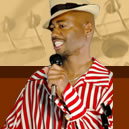Picture It
presented for the
CDC National HIV Prevention Conference 2009 Opening Plenary
Sunday August 23, 2009
I dedicate tonight’s remarks to three people who Bayard Rustin might describe as angelic troublemakers—Debbie Thomas Bryant, Richard Anderson and Allen Thornell –three who are no longer here and continue to inspire me to action.
Picture it! 1981 in the Black and Latino Brooklyn village known as Fort Greene. It was a year of many firsts as I was very young and possessed of a boldness I mistook for courage. I lived with two roommates in my first apartment, a brownstone flat on Cumberland St. I was crazy in love with my first boyfriend and quite pleased to have escaped the looming shadow of my father’s raised brow. It was during those days when I warned our friend Ricky about traipsing over to Man’s Country, one of the hottest bathhouses in midtown. AThere’s some gay cancer going around that’s hitting the white boys,@ I told him. Ricky loved, loved, loved him some white boys and he was also decidedly anti-monogamous. I thought he did not have sense enough to be afraid so I was afraid for him. Although I suggested that he settle down and get a boyfriend like mine, whom I later discovered he was having, I also envied his ability to skip through sexual playgrounds I only dared visit in my fantasies.
I had no clue that a plague of unparalleled dimensions had already broken through the barricades. That it would wash all over us, taint our bodies and stain our lenses so that we would never look at each other the same. For the first decade it was all we could talk about, or not talk about, our silences betrayed by the fear beaming from our eyes. ANow we think as we fuck!@ Essex Hemphill signaled. AThis nut might kill us.@ In 1985, I found myself host to the unwelcome stranger.
Although our accomplishments were mostly omitted in the histories written by white gays and black straights, we crafted tools for our survival and legacies for our progeny. Essex wrote AI want to start an organization to save my own life@ and Phill Wilson who would later start the Black AIDS Institute, co-founded the Black Gay and Lesbian Leadership Forum. Carl Bean joyously proclaimed At’aint a fault, it’s a fact, I was born this way@ and launched an inclusive Black church movement. Other Countries, a black gay men’s writing collective delivered performance pieces about AIDS at Studio Museum of Harlem and the club Traxx.
I used t wonder how different the world and I would be had the plague never happened. I find it much more useful to imagine the kind of community we would own if Hemphill, Assoto Saint, Marlon Riggs, and thousands of unnamed angelic troublemakers had lived to see this day! I am then visited by spectacles of what could be. A gala premiere of Marlon Riggs 20th film at a Black gay owned arts center in Atlanta where hundreds line up to meet the gray bearded director. Primetime coverage of mass walkouts and demonstrations at homophobic black churches across the nation. Universal health coverage that ensures quality services for people of any sexual orientation, gender identity or income level. A full range of funded prevention options afforded by a National AIDS plan including vaccines, microbicides, and mental health services that have dramatically lowered infection rates. Interventions unyoked by political machinations and fundamentalist ideologies, and informed by research conducted by young Black scientists.
Then I reawaken to my sobering reality and I am reminded of my purpose
If we are going to make it then we must look past simply surviving HIV because that is not what hints at our extinction. HIV is only the most visible symptom. It is the trauma we bear from the abuse of relatives and pastors who called us sissies and bulldykes in the daylight and sweet thing at night. It is Us sometimes hurting us, our own leaders stabbing each other in the back for a grant or a leadership title. It is the silent complicity of our hetero sisters and brothas who will party or pray with us but will not show up at the protest march.
We must concentrate on de-stigmatizing queer identities throughout black communities. Many of us have stories of love and acceptance from our people as familiar as the George Jefferson dance. These narratives are rarely broadcast as normative. Black family/community campaigns that convey messages of acceptance and breakthroughs that occur. Imagine a primetime TV commercial featuring a churchgoing mother praising her middle aged HIV+ gay son or one father challenging another to his accept his lesbian daughter. It’s about time we started working our own positive campaign promoting black love among our people!
People in their sixties and seventies reminisce as a way of making sense of their lives. As a 49 year old gay man who has lived with HIV nearly half my life and has lost my share of friends, I reminisce quite often. I ponder what could have been in order to stay clear about what could still be.
It is not enough to state what we do not want. We must determine what we do want and work in that direction. It will take more than updates on escalating HIV rates to mobilize us to action. We need a better incentive, not just something to escape or withstand, but something positive to reach for. Let it be us loving us in ways that could have been had we not lost so many angels. Look to their words and their lives for models we can use. Are not we as Joseph Beam offered, Aworth wanting each other@? Picture it!
back to top |









